
Wine Culture and Information since 2002 - Volume 22
 Wine Culture and Information since 2002 - Volume 22 |
|
Contrasts of Valpolicella Ripasso and Bolgheri RossoTwo red wines from Veneto and Tuscany, among the most famous ones of the two regions, are compared in the glasses of the tasting by contrast of this month |
|
Veneto and Tuscany are among the most important wine-producing regions of Italy and their wines are famous and celebrated among the enthusiasts of the beverage of Bacchus. In fact, in these two regions, are being produced many of the winemaking excellences of Italy and are famous everywhere in the world. Both Veneto and Tuscany have a long history and tradition in the production of wines and their ampelographic heritage – made of indigenous and international varieties – is decidedly rich, both for white and red grapes. Amarone della Valpolicella, Prosecco, Soave, Brunello di Montalcino, Chianti and Morellino di Scansano are in fact just some of the wines identifying the two regions and have made them famous throughout the world. When it comes to grapes, as far as red varieties are concerned, here we have two important grapes that are protagonists in the wines of the region: Sangiovese in Tuscany, Corvina in Veneto. In fact, the wines we will examine in this month's tasting by contrast allow – according to the respective production disciplinaries – the use of these two varieties. The wines we are going to pour into our glasses are in fact, as far as Tuscany is concerned, Bolgheri Rosso and Valpolicella Ripasso for Veneto. In both cases these wines are produced with many varieties and, as for Bolgheri Rosso, its production can also be made as a mono-varietal wine. In this regard, it should be considered that in the Tuscan wine, the presence of Sangiovese is allowed but not mandatory and, as we will see later, this wine is mainly composed of international grapes. Valpolicella Ripasso is usually produced with indigenous varieties of the province of Verona, however in its composition can also be used grapes allowed for cultivation in the Veronese area and, among them, international varieties as well.
|
|
The territory of Valpolicella is certainly the most famous area of Veneto for the production of red wines. It is a rather “complex” denomination which includes the production of four wines, each belonging to its own denomination, all identified with the name of this territory: Amarone della Valpolicella, Recioto della Valpolicella, Valpolicella Ripasso and Valpolicella. The wines of these appellations share the use of the same varieties – mainly Corvina, Corvinone, Rondinella and Molinara – and they differ in the production technique. This difference, of course, gives the wines a profoundly different personality and character, therefore the character of Valpolicella is, for example, extremely distant from the one of Amarone della Valpolicella. In this specific case, these are two wines that are found in opposite sides of the territory and in the midst of which we find – in purely productive and therefore sensorial terms – Valpolicella Ripasso. Because of its wine making characteristics, Valpolicella Ripasso is considered by some to be a “lesser Amarone”, indeed the two wines are quite different, especially in sensorial terms. The first fundamental distinction is that Valpolicella Ripasso is produced with ripe and fresh grapes, whereas in Amarone della Valpolicella are used dried grapes instead. Valpolicella Ripasso takes its name from the particular production technique involving the maceration of Valpolicella wine in the pomace – that is the skins of crushed grapes – used for the production of Amarone della Valpolicella or Recioto della Valpolicella. Maceration generally lasts for 15-20 days and enriches the wine with the sugar and aromas present in the pomace. This operation therefore favors a new fermentation with the result of enriching the Valpolicella with structure and alcohol. It must be said the disciplinary also allows the addition of dried grapes and leaves the producer the freedom of choosing the maceration technique. At the end of this operation Valpolicella Ripasso follows the aging practices according to the choice of the producer.
|
||||
|
Bolgheri wines produced in recent times owe their fame and glory to the so-called international varieties and, in particular, to those of the Bordeaux area, in France. In many respects, the modern renaissance of Italian wine was born in this area in the province of Livorno and overlooking the Tyrrhenian Sea. It all began in the late 1960s when Marquis Mario Incisa della Rocchetta gave birth to his dream of creating a great wine inspired by the model and fame of those of Bordeaux. To do this, he accepted the help of the greatest Italian winemaker – Giacomo Tachis – and together they created a wine that still today is at the height of the Olympus of Italian wine: Sassicaia. To achieve this excellent result, the famous Bordeaux varieties were introduced into the vineyards of Marquis Incisa della Rocchetta, favoring Cabernet Sauvignon and Cabernet Franc. The success of this wine has then influenced the viticultural choices of the other producers in this area, who planted international varieties in their vineyards with the aim of replicating the success of Sassicaia. Bolgheri Rosso, a Denominazione d'Origine Controllata wine (Denomination of Controlled Origin) is definitely the son of that extraordinary period and which has strongly contributed to the revival of Italian wine in the world. For this reason, in this wine we mainly find Cabernet Sauvignon, Cabernet Franc, Merlot, Syrah and Sangiovese grapes. It must be said the production disciplinary provides for a maximum quantity of 50% for Syrah and Sangiovese, while for the other three grapes it is also possible to use them for a quantity of 100%, furthermore it can also be used, for a maximum of 30%, red grape varieties allowed in Tuscany. This means Bolgheri Rosso could also be a mono-varietal wine produced with one of the first three varieties listed above. It must be said, however, the choice of producers is often in favor of Cabernet Sauvignon and that it is usually blended with the other varieties allowed by the production disciplinary. As for the aging, Bolgheri Rosso must age for at least one year in cask, however, in this sense, the choice of producers is usually in favor of the barrique.
|
In the tasting by contrast of this month we are going to compare two wines produced in different territories and with grapes of distinct origins: native varieties in case of Valpolicella Ripasso, international grapes in Bolgheri Rosso. It must be said the purpose of the tasting is not to tell which is the best of the two and the only educational goal is to compare two different wines with the aim of understanding the respective differences and qualities. In both cases the choice is in favor of wines aged in cask, possibly of the same type, for example the barrique. In particular, as for Bolgheri Rosso, our choice is in favor of a wine produced with Cabernet Sauvignon, Cabernet Franc and Merlot, possibly with a small quantity of Sangiovese. Because of the enological techniques used for the production of these two wines, in particular the time required for the aging before being marketed, in both cases we will choose bottles three or four years old. The evaluation of the wines is done at a temperature of 18 °C (65 °F) using tasting glasses. After having poured the two wines in their respective glasses, we begin the tasting by contrast of this month. The first aspect we will examine is the one relating to how wines appear to our eyes, starting from Valpolicella Ripasso. We place the tilted glass over a white surface and observe its base in order to evaluate the color and transparency of the wine. We can see an intense and brilliant ruby red color with a moderate transparency, we can also see the object placed in contrast between the glass and the white surface. Let's now assess the nuance of Valpolicella Ripasso, by observing the wine at the upper edge, towards the opening of the glass: the color is clearly garnet red. Let's proceed with the evaluation of the aspect of Bolgheri Rosso, holding the glass – also in this case – tilted over the white surface. The color of the Tuscan wine is intense ruby red and evidently darker than Valpolicella Ripasso. The transparency is decidedly lower than the one of the wine from Veneto. Let's now asses the nuance of Bolgheri Rosso: the intense ruby red color is clearly visible. Valpolicella Ripasso and Bolgheri Rosso give the nose extremely different olfactory profiles. The cause, of course, is mainly determined by the grapes used for their production and, not least, the territory and the wine making techniques. Valpolicella Ripasso – mainly produced with Corvina, Corvinone and Rondinella grapes – gives the nose aromas of plum, black cherry, blackberry, blueberry, sometimes cherry, to which usually follows violet. Moreover, in Valpolicella Ripasso, it is possible to perceive aromas reminiscent of red-pulp fruits, including raspberry and pomegranate. Quite different, and in some ways more severe, the profile of Bolgheri Rosso in which can be appreciated to the nose intense and clean aromas of black currant, plum and black cherry, frequently followed by the floral elegance of violet and iris. In both wines, because of the aging in wood, we can perceive tertiary aromas such as vanilla, chocolate – as well as cocoa – tobacco and even aromatic herbs, to which are added pleasant hints of balsamic aromas such as menthol and eucalyptus. Let's continue the sensorial analysis of the wines of our tasting by contrast, and evaluate the olfactory profile of Valpolicella Ripasso. By holding the glass in vertical position and without swirling, we proceed with the first smell in order to evaluate the opening of the wine, that is the first olfactory sensations perceived to the nose. From the glass we perceive, clear and intense, pleasant aromas of plum, blackberry and black cherry followed by the unmistakable floral aroma of violet. Let's swirl the glass and proceed with the second smell and evaluate the remaining aromas of the Valpolicella Ripasso. From the glass we perceive blueberry, raspberry, pomegranate accompanied by tertiary sensations – given by the aging in wood – in which we recognize chocolate, tobacco, cinnamon, vanilla and a pleasant balsamic hint of menthol. Let's now pass to the evaluation of the opening of Bolgheri Rosso. The first smell allows the perception of intense and clean aromas of black currant, plum, black cherry and the pleasant floral scent of violet. After having swirled the glass, the second smell completes the olfactory profile of Bolgheri Rosso with blueberry and iris, followed – also in this case – by the aromas given by the aging in wood and in which we recognize cocoa, tobacco, mace and the balsamic touch of eucalyptus. Let's now proceed with the evaluation of the gustatory profiles of the wines of our tasting by contrast and, as in the previous phases, we focus our attention in Valpolicella Ripasso. Let's take a sip of the wine from Veneto in order to evaluate its attack, that is the primary sensations the wine produces in the mouth. We perceive a moderate and not excessively intense astringency, in which tends to predominate a good roundness and which is also combined with the one given both by the specific qualities of the ripasso technique and the aging in wood. We can also clearly perceive the pseudo-burning effect of alcohol which further contributes to the roundness of the wine. In the mouth we can also clearly perceive intense flavors of plum, blackberry and black cherry. Let's now take a sip of Bolgheri Rosso and evaluate its attack: in the mouth we perceive a decidedly evident astringency – mainly because of Cabernet Sauvignon – and the roundness is clearly lower than Valpolicella Ripasso. Also in this wine the effect of alcohol is evident, which in any case contributes to the balance of tannins. Moreover, flavors of black currant, black cherry, plum and blueberry can be perceived in the mouth. Our tasting by contrast ends with the evaluation of the final sensations the wines leave in the mouth, in particular, the taste-olfactory persistence, one of the main factors defining the quality of a wine. The finish of Valpolicella Ripasso is decidedly persistent and in the mouth we continue to perceive the pleasing roundness and moderate astringency, in addition to a good structure. We can also perceive intense and pleasing flavors of blackberry, plum and black cherry. The finish of Bolgheri Rosso is equally persistent – therefore confirming its good quality – however the sensation of astringency is decidedly stronger compared to Valpolicella Ripasso and the sensation of roundness is lower than the wine from Veneto. In the mouth we continue to clearly perceive the flavors of black currant, black cherry, plum and blueberry. Finally, we proceed with the last smell of the two wines, Valpolicella Ripasso first, then Bolgheri Rosso: the differences in the olfactory profiles are clearly evident and distant.
|
||||||||
Wines of the Month |
|
|
|
Score legend Prices are to be considered as indicative. Prices may vary according to the country or the shop where wines are bought |
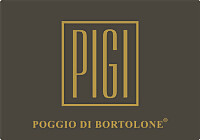
|
|
Sicilia Rosso Pigi 2017 |
|
| Poggio di Bortolone (Sicily, Italy) | |
 Syrah (60%), Cabernet sauvignon (40%) Syrah (60%), Cabernet sauvignon (40%) | |
| Price: € 18.50 | Score: |
 Intense ruby red and nuances of garnet red, little transparency. Intense ruby red and nuances of garnet red, little transparency. Intense, clean, pleasing and refined, starts with hints of black
cherry, black currant and plum followed by aromas of violet, blueberry,
blackberry, carob, tobacco, vanilla and menthol. Intense, clean, pleasing and refined, starts with hints of black
cherry, black currant and plum followed by aromas of violet, blueberry,
blackberry, carob, tobacco, vanilla and menthol.
 Properly tannic attack and however balanced by alcohol, good body,
intense flavors, agreeable. Properly tannic attack and however balanced by alcohol, good body,
intense flavors, agreeable.
 Persistent finish with flavors of black cherry, black currant and plum. Persistent finish with flavors of black cherry, black currant and plum. 18 months in steel tanks, 9 months in cask. 18 months in steel tanks, 9 months in cask. |
|
 Broiled meat and barbecue, Stewed meat with mushrooms, Roasted meat, Cheese Broiled meat and barbecue, Stewed meat with mushrooms, Roasted meat, Cheese |
|
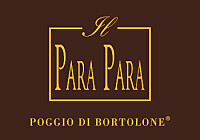
|
|
Cerasuolo di Vittoria Classico Il Para Para 2016 |
|
| Poggio di Bortolone (Sicily, Italy) | |
 Nero d'Avola (60%), Frappato (40%) Nero d'Avola (60%), Frappato (40%) | |
| Price: € 17.00 | Score: |
 Intense ruby red and nuances of garnet red, moderate transparency. Intense ruby red and nuances of garnet red, moderate transparency. Intense, clean, pleasing and refined, starts with hints of plum, black
cherry and blackberry followed by aromas of geranium, raspberry,
strawberry, carob, tobacco, black pepper and vanilla. Intense, clean, pleasing and refined, starts with hints of plum, black
cherry and blackberry followed by aromas of geranium, raspberry,
strawberry, carob, tobacco, black pepper and vanilla.
 Properly tannic attack and however balanced by alcohol, good body,
intense flavors, agreeable. Properly tannic attack and however balanced by alcohol, good body,
intense flavors, agreeable.
 Persistent finish with flavors of plum, black cherry and blackberry. Persistent finish with flavors of plum, black cherry and blackberry. 18 months in steel tanks, 9 months in cask, 6 months in bottle. 18 months in steel tanks, 9 months in cask, 6 months in bottle. |
|
 Broiled meat and barbecue, Roasted meat, Stewed meat, Cheese Broiled meat and barbecue, Roasted meat, Stewed meat, Cheese |
|

|
|
Brunello di Montalcino Pelagrilli 2014 |
|
| Siro Pacenti (Tuscany, Italy) | |
 Sangiovese Sangiovese | |
| Price: € 45.00 | Score: |
 Brilliant ruby red and nuances of garnet red, little transparency. Brilliant ruby red and nuances of garnet red, little transparency. Intense, clean, pleasing, refined and elegant, starts with hints of
black cherry, plum and violet followed by aromas of raspberry, blueberry,
rose, cedar, chocolate, tobacco, cinnamon, licorice, mace, pink pepper,
vanilla and menthol. Intense, clean, pleasing, refined and elegant, starts with hints of
black cherry, plum and violet followed by aromas of raspberry, blueberry,
rose, cedar, chocolate, tobacco, cinnamon, licorice, mace, pink pepper,
vanilla and menthol.
 Tannic attack and however balanced by alcohol, full body, intense
flavors, pleasing crispness. Tannic attack and however balanced by alcohol, full body, intense
flavors, pleasing crispness.
 Very persistent finish with long flavors of black cherry, plum and
raspberry. Very persistent finish with long flavors of black cherry, plum and
raspberry.
 24 months in barrique. 24 months in barrique. |
|
 Game, Roasted meat, Stewed and braised meat, Hard cheese Game, Roasted meat, Stewed and braised meat, Hard cheese |
|

|
|
Brunello di Montalcino Vecchie Vigne 2014 |
|
| Siro Pacenti (Tuscany, Italy) | |
 Sangiovese Sangiovese | |
| Price: € 85.00 | Score: |
 Brilliant ruby red and nuances of garnet red, moderate transparency. Brilliant ruby red and nuances of garnet red, moderate transparency. Intense, clean, pleasing, refined and elegant, starts with hints of
black cherry, plum and raspberry followed by aromas of violet, blueberry,
rose, chocolate, pink pepper, cigar box, tobacco, cinnamon, licorice, mace,
leather, leather and menthol. Intense, clean, pleasing, refined and elegant, starts with hints of
black cherry, plum and raspberry followed by aromas of violet, blueberry,
rose, chocolate, pink pepper, cigar box, tobacco, cinnamon, licorice, mace,
leather, leather and menthol.
 Properly tannic attack and however balanced by alcohol, full body,
intense flavors, pleasing crispness. Properly tannic attack and however balanced by alcohol, full body,
intense flavors, pleasing crispness.
 Very persistent finish with long flavors of black cherry, plum and
raspberry. Very persistent finish with long flavors of black cherry, plum and
raspberry.
 24 months in barrique. 24 months in barrique. |
|
 Game, Roasted meat, Stewed and braised meat, Hard cheese Game, Roasted meat, Stewed and braised meat, Hard cheese |
|
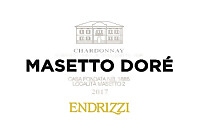
|
|
Masetto Doré 2017 |
|
| Endrizzi (Trentino, Italy) | |
 Chardonnay Chardonnay | |
| Price: € 19.50 | Score: |
 Brilliant golden yellow and nuances of golden yellow, very transparent. Brilliant golden yellow and nuances of golden yellow, very transparent. Intense, clean, pleasing, refined and elegant, starts with hints of
banana, plum and apple followed by aromas of acacia, grapefruit, pear,
butter, praline, peach, citron, hawthorn, rosemary, vanilla and flint. Intense, clean, pleasing, refined and elegant, starts with hints of
banana, plum and apple followed by aromas of acacia, grapefruit, pear,
butter, praline, peach, citron, hawthorn, rosemary, vanilla and flint.
 Crisp attack and however balanced by alcohol, good body, intense
flavors, pleasing roundness. Crisp attack and however balanced by alcohol, good body, intense
flavors, pleasing roundness.
 Persistent finish with flavors of banana, apple and praline. Persistent finish with flavors of banana, apple and praline. Fermented and aged in barrique. Fermented and aged in barrique. |
|
 Roasted fish, Roasted white meat, Stuffed pasta, Mushroom soups Roasted fish, Roasted white meat, Stuffed pasta, Mushroom soups |
|
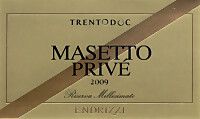
|
|
Trento Dosaggio Zero Riserva Masetto Privé 2009 |
|
| Endrizzi (Trentino, Italy) | |
 Chardonnay Chardonnay | |
| Price: € 69.00 | Score: |
 Intense golden yellow and nuances of golden yellow, very
transparent, fine and persistent perlage. Intense golden yellow and nuances of golden yellow, very
transparent, fine and persistent perlage.
 Intense, clean, pleasing, refined and elegant, starts with hints of
ripe banana, apple and bread crust followed by aromas of grapefruit,
hawthorn, candied fruits, pear, plum, grapefruit, praline, honey,
croissant, flint and hints of vanilla. Intense, clean, pleasing, refined and elegant, starts with hints of
ripe banana, apple and bread crust followed by aromas of grapefruit,
hawthorn, candied fruits, pear, plum, grapefruit, praline, honey,
croissant, flint and hints of vanilla.
 Crisp and effervescent attack, however balanced by alcohol, good
body, intense flavors, pleasing roundness. Crisp and effervescent attack, however balanced by alcohol, good
body, intense flavors, pleasing roundness.
 Persistent finish with flavors of ripe banana, grapefruit and praline. Persistent finish with flavors of ripe banana, grapefruit and praline. Part of the base wine is fermented in barrique and cask. Refermented
in bottle on its lees for at least 84 months. Part of the base wine is fermented in barrique and cask. Refermented
in bottle on its lees for at least 84 months.
|
|
 Stuffed pasta, Mushroom soups, Roasted white meat, Stewed meat, Roasted fish Stuffed pasta, Mushroom soups, Roasted white meat, Stewed meat, Roasted fish |
|
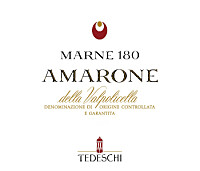
|
|
Amarone della Valpolicella Marne 180 2015 |
|
| Tedeschi (Veneto, Italy) | |
 Corvina (35%), Corvinone (35%), Rondinella (20%), Rossignola, Oseleta, Negrara, Dindarella (10%) Corvina (35%), Corvinone (35%), Rondinella (20%), Rossignola, Oseleta, Negrara, Dindarella (10%) | |
| Price: € 35.00 | Score: |
 Intense ruby red and nuances of garnet red, little transparency. Intense ruby red and nuances of garnet red, little transparency. Intense, clean, pleasing, refined and elegant, starts with hints of
plum, blackberry and black cherry followed by aromas of dried violet,
blueberry, black currant, tobacco, leather, chocolate, mace, pink pepper,
vanilla and menthol. Intense, clean, pleasing, refined and elegant, starts with hints of
plum, blackberry and black cherry followed by aromas of dried violet,
blueberry, black currant, tobacco, leather, chocolate, mace, pink pepper,
vanilla and menthol.
 Tannic attack and however balanced by alcohol, full body, intense
flavors, pleasing roundness. Tannic attack and however balanced by alcohol, full body, intense
flavors, pleasing roundness.
 Persistent finish with flavors of plum, blackberry and black cherry. Persistent finish with flavors of plum, blackberry and black cherry. 3 years in cask, 3 months in bottle. 3 years in cask, 3 months in bottle. |
|
 Game, Stewed and braised meat, Roasted meat, Hard cheese Game, Stewed and braised meat, Roasted meat, Hard cheese |
|
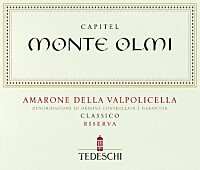
|
|
Amarone della Valpolicella Classico Riserva Capitel Monte Olmi 2013 |
|
| Tedeschi (Veneto, Italy) | |
 Corvina (30%), Corvinone (30%), Rondinella (30%), Oseleta, Negrara, Dindarella, Croatina, Forselina (10%) Corvina (30%), Corvinone (30%), Rondinella (30%), Oseleta, Negrara, Dindarella, Croatina, Forselina (10%) | |
| Price: € 55.00 | Score: |
 Deep ruby red and nuances of garnet red, little transparency. Deep ruby red and nuances of garnet red, little transparency. Intense, clean, pleasing, refined and elegant, starts with hints of
blackberry, plum and black cherry followed by aromas of dried violet,
blueberry, cocoa, carob, tobacco, cinnamon, clove, licorice, leather, pink
pepper, mace, vanilla and menthol. Intense, clean, pleasing, refined and elegant, starts with hints of
blackberry, plum and black cherry followed by aromas of dried violet,
blueberry, cocoa, carob, tobacco, cinnamon, clove, licorice, leather, pink
pepper, mace, vanilla and menthol.
 Tannic attack and however balanced by alcohol, full body, intense
flavors, pleasing roundness. Tannic attack and however balanced by alcohol, full body, intense
flavors, pleasing roundness.
 Very persistent finish with long flavors of blackberry, plum and black
cherry. Very persistent finish with long flavors of blackberry, plum and black
cherry.
 4 years in cask, 6 months in bottle. 4 years in cask, 6 months in bottle. |
|
 Game, Stewed and braised meat, Roasted meat, Hard cheese Game, Stewed and braised meat, Roasted meat, Hard cheese |
|
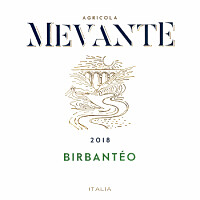
|
|
Birbanteo 2018 |
|
| Mevante (Umbria, Italy) | |
 Trebbiano Spoletino Trebbiano Spoletino | |
| Price: € 12.00 | Score: |
 Intense straw yellow and nuances of straw yellow, very transparent. Intense straw yellow and nuances of straw yellow, very transparent. Intense, clean, pleasing and refined, starts with hints of apple,
citrus fruits and plum followed by aromas of medlar, peach, pear, hawthorn,
melon, broom and pineapple. Intense, clean, pleasing and refined, starts with hints of apple,
citrus fruits and plum followed by aromas of medlar, peach, pear, hawthorn,
melon, broom and pineapple.
 Crisp attack and however balanced by alcohol, good body, intense
flavors, agreeable. Crisp attack and however balanced by alcohol, good body, intense
flavors, agreeable.
 Persistent finish with flavors of apple, peach and medlar. Persistent finish with flavors of apple, peach and medlar. 6 months in steel tanks. 6 months in steel tanks. |
|
 Stuffed pasta, Broiled fish, Stewed fish, Roasted white meat Stuffed pasta, Broiled fish, Stewed fish, Roasted white meat |
|
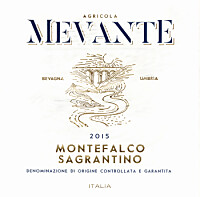
|
|
Montefalco Sagrantino 2015 |
|
| Mevante (Umbria, Italy) | |
 Sagrantino Sagrantino | |
| Price: € 24.00 | Score: |
 Intense ruby red and nuances of garnet red, little transparency. Intense ruby red and nuances of garnet red, little transparency. Intense, clean, pleasing, refined and elegant, starts with hints of
blackberry, plum and black cherry followed by aromas of dried violet,
blueberry, green bean, chocolate, tobacco, cinnamon, mace, vanilla and
menthol. Intense, clean, pleasing, refined and elegant, starts with hints of
blackberry, plum and black cherry followed by aromas of dried violet,
blueberry, green bean, chocolate, tobacco, cinnamon, mace, vanilla and
menthol.
 Tannic attack and however balanced by alcohol, full body, intense
flavors, pleasing roundness. Tannic attack and however balanced by alcohol, full body, intense
flavors, pleasing roundness.
 Persistent finish with flavors of blackberry, plum and black cherry. Persistent finish with flavors of blackberry, plum and black cherry. 24 months in cask, 12 months in bottle. 24 months in cask, 12 months in bottle. |
|
 Game, roasted meat, Stewed and braised meat, Hard cheese Game, roasted meat, Stewed and braised meat, Hard cheese |
|
|
||||||||
|
DiWineTaste Polls
|
| |||||||
Privacy Policy | |||||||


| Copyright © 2002-2024 Antonello Biancalana, DiWineTaste - All rights reserved |
| All rights reserved under international copyright conventions. No part of this publication and of this WEB site may be
reproduced or utilized in any form or by any means, electronic or mechanical, without permission in writing from DiWineTaste. |